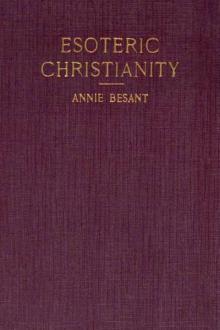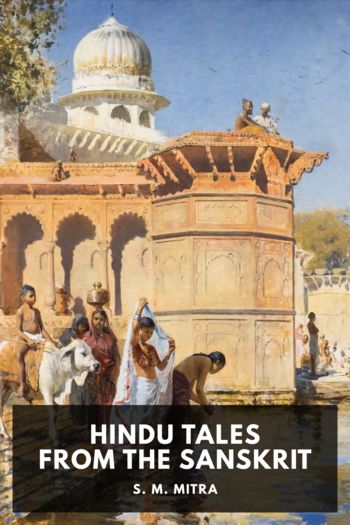Esoteric Christianity, Annie Besant [good short books txt] 📗

- Author: Annie Besant
- Performer: -
Book online «Esoteric Christianity, Annie Besant [good short books txt] 📗». Author Annie Besant
As above said by the learned Dean, the idea of the Word, the Logos, was universal, and it formed part of the idea of a Trinity. Among the Hindus, the philosophers speak of the manifested Brahman as Sat-Chit-Ananda, Existence, Intelligence, and Bliss. Popularly, the Manifested God is a Trinity; Shiva, the Beginning and the End; Vishnu, the Preserver; Brahmâ, the Creator of the Universe. The Zoroastrian faith presents a similar Trinity; Ahuramazdao, the Great One, the First; then "the twins," the dual Second Person—for the Second Person in a Trinity is ever dual, deteriorated in modern days into an opposing God and Devil—and the Universal Wisdom, Armaiti. In Northern Buddhism we find Amitâbha, the boundless Light; Avalokiteshvara, the source of incarnations, and the Universal Mind, Mandjusri. In Southern Buddhism the idea of God has faded away, but with significant tenacity the triplicity re-appears as that in which the Southern Buddhist takes his refuge—the Buddha, the Dharma (the Doctrine), the Sangha (the Order). But the Buddha Himself is sometimes worshipped as a Trinity; on a stone in Buddha Gaya is inscribed a salutation to Him as an incarnation of the Eternal One, and it is said: "Om! Thou art Brahmâ, Vishnu, and Mahesha (Shiva) ... I adore Thee, who art celebrated by a thousand names and under various forms, in the shape of Buddha, the God of Mercy."[261]
In extinct religions the same idea of a Trinity is found. In Egypt it dominated all religious worship. "We have a hieoroglyphical inscription in the British Museum as early as the reign of Senechus of the eighth century before the Christian era, showing that the doctrine of Trinity in Unity already formed part of their religion."[262] This is true of a far earlier date. Râ, Osiris, and Horus formed one widely worshipped Trinity; Osiris, Isis, and Horus were worshipped at Abydos; other names are given in different cities, and the triangle is the frequently used symbol of the Triune God. The idea which underlay these Trinities, however named, is shown in a passage quoted from Marutho, in which an oracle, rebuking the pride of Alexander the Great, speaks of: "First God, then the Word, and with Them the Spirit."[263]
In Chaldæa, Anu, Ea, and Bel were the Supreme Trinity, Anu being the Origin of all, Ea the Wisdom, and Bel the creative Spirit. Of China Williamson remarks: "In ancient China the emperors used to sacrifice every third year to 'Him who is one and three.' There was a Chinese saying, 'Fo is one person but has three forms.' ... In the lofty philosophical system known in China as Taoism, a trinity also figures: 'Eternal Reason produced One, One produced Two, Two produced Three, and Three produced all things,' which, as Le Compte goes on to say, 'seems to show as if they had some knowledge of the Trinity.'"[264]
In the Christian doctrine of the Trinity we find a complete agreement with other faiths as to the functions of the three Divine Persons, the word Person coming from persona, a mask, that which covers something, the mask of the One Existence, Its Self-revelation under a form. The Father is the Origin and End of all; the Son is dual in His nature, and is the Word, or the Wisdom; the Holy Spirit is the creative Intelligence, that brooding over the chaos of primeval matter organises it into the materials out of which forms can be constructed.
It is this identity of functions under so many varying names which shows that we have here not a mere outer likeness, but an expression of an inner truth. There is something of which this triplicity is a manifestation, something that can be traced in nature and in evolution, and which, being recognised, will render intelligible the growth of man, the stages of his evolving life. Further, we find that in the universal language of symbolism the Persons are distinguished by certain emblems, and may be recognised by these under diversity of forms and names.
But there is one other point that must be remembered ere we leave the exoteric statement of the Trinity—that in connection with all these Trinities there is a fourth fundamental manifestation, the Power of the God, and this has always a feminine form. In Hinduism each Person in the Trinity has His manifested Power, the One and these six aspects making up the sacred Seven. With many of the Trinities one feminine form appears, then ever specially connected with the Second Person, and then there is the sacred Quaternary.
Let us now see the inner truth.
The One becomes manifest as the First Being, the Self-Existent Lord, the Root of all, the Supreme Father; the word Will, or Power, seems best to express this primary Self-revealing, since until there is Will to manifest there can be no manifestation, and until there is Will manifested, impulse is lacking for further unfoldment. The universe may be said to be rooted in the divine Will. Then follows the second aspect of the One—Wisdom; Power is guided by Wisdom, and therefore it is written that "without Him was not anything made that is made;"[265] Wisdom is dual in its nature, as will presently be seen. When the aspects of Will and Wisdom are revealed, a third aspect must follow to make them effective—Creative Intelligence, the divine mind in Action. A Jewish prophet writes: "He hath made the earth by His Power, He hath established the world by His Wisdom; and hath stretched out the heaven by His Understanding,"[266] the reference to the three functions being very clear.[267] These Three are inseparable, indivisible, three aspects of One. Their functions may be thought of separately, for the sake of clearness, but cannot be disjoined. Each is necessary to each, and each is present in each. In the First Being, Will, Power, is seen as predominant, as characteristic, but Wisdom and Creative Action are also present; in the Second Being, Wisdom is seen as predominant, but Power and Creative Action are none the less inherent in Him; in the Third Being, Creative Action is seen as predominant, but Power and Wisdom are ever also to be seen. And though the words First, Second, Third are used, because the Beings are thus manifested in Time, in the order of Self-unfolding, yet in Eternity they are known as interdependent and co-equal, "None is greater or less than Another."[268]
This Trinity is the divine Self, the divine Spirit, the Manifested God, He that "was and is and is to come,"[269] and He is the root of the fundamental triplicity in life, in consciousness.
But we saw that there was a Fourth Person, or in some religions a second Trinity, feminine, the Mother. This is That which makes manifestation possible, That which eternally in the One is the root of limitation and division, and which, when manifested, is called Matter. This is the divine Not-Self, the divine Matter, the manifested Nature. Regarded as One, She is the Fourth, making possible the activity of the Three, the Field of Their operations by virtue of Her infinite divisibility, at once the "Handmaid of the Lord,"[270] and also His Mother, yielding of Her substance to form His Body, the universe, when overshadowed by His power.[271] Regarded carefully She is seen to be triple also, existing in three inseparable aspects, without which She could not be. These are Stability—Inertia or Resistance—Motion, and Rhythm; the fundamental or essential qualities of Matter, these are called. They alone render Spirit effective, and have therefore been regarded as the manifested Powers of the Trinity. Stability or Inertia affords a basis, the fulcrum for the lever; Motion is then rendered manifest, but could make only chaos, then Rhythm is imposed, and there is Matter in vibration, capable of being shaped and moulded. When the three qualities are in equilibrium, there is the One, the Virgin Matter, unproductive. When the power of the Highest overshadows Her, and the breath of the Spirit comes upon Her, the qualities are thrown out of equilibrium, and She becomes the divine Mother of the worlds.
The first interaction is between Her and the Third Person of the Trinity; by His action She becomes capable of giving birth to form. Then is revealed the Second Person, who clothes Himself in the material thus provided, and thus become the Mediator, linking in His own Person Spirit and Matter, the Archetype of all forms. Only through Him does the First Person become revealed, as the Father of all Spirits.
It is now possible to see why the Second Person of the Trinity of Spirit is ever dual; He is the One who clothes Himself in Matter, in whom the twin-halves of Deity appear in union, not as one. Hence also is He Wisdom; for Wisdom on the side of Spirit is the Pure Reason that knows itself as the One Self and knows all things in that Self, and on the side of Matter it is Love, drawing the infinite diversity of forms together, and making each form a unit, not a mere heap of particles—the principle of attraction which holds the worlds and all in them in a perfect order and balance. This is the Wisdom which is spoken of as "mightily and sweetly ordering all things,"[272] which sustains and preserves the universe.
In the world-symbols, found in every religion, the Point—that which has position only—has been taken as a symbol of the First Person in the Trinity. On this symbol St. Clement of Alexandria remarks that we abstract from a body its properties, then depth, then breadth, then length; "the point which remains is a unit, so to





Comments (0)